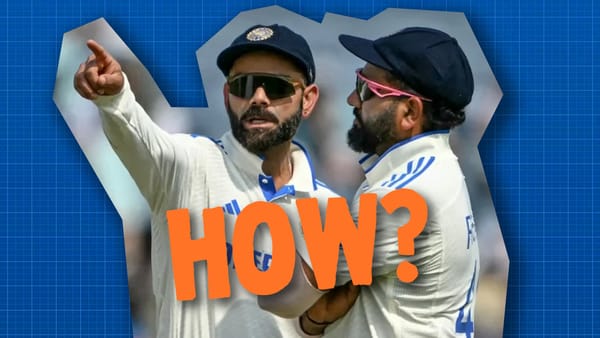The Rohit Prism
Looking at batting errors with help from Rohit Sharma
Rohit Sharma went out yesterday, I tweeted about it today and my Twitter hasn't stopped since.
Rohit Sharma has opened in three innings outside of India in his life. Against the best seam bowling attack in the world. Coming off an injury and being unprepared. In those 3 innings he's averaged 40. And people think he's been so bad he gets only one more chance?
— Jarrod Kimber (@ajarrodkimber) 9:29 PM ∙ Jan 16, 2021
Cool story
I wanted to put Rohit's innings in context. Because when a batsman gets caught on the rope for less than 100, context gets hit for six.
It should go without saying there is no one way to bat in Tests and you are going to fail. Bradman didn't make 20 almost 25% of the time. He also made seven ducks and went out another 14 times between 20 and 50.
The best batsman ever - worth double the runs of many greats - often went out when set. He hit the ball in the air when he should have kept it on the ground. He could lose patience, he loved to score, and would sometimes get out forcing the pace. He played across the line and missed balls. And on occasion, he made a superb choice but executed it terribly.
A successful Test batsman needs to be 40 to 45% as good as Bradman.
This is all batsmen, the nuggety guy you can't help but love even though he is so boring. Or Rohit Sharma, the guy who hasn't made many runs away from home, and somehow has played one Test for each year he's been alive. Rohit comes with so much baggage that we'd need a porter to assist us.
But I very much don't want to write a Rohit piece. I want to talk about how we look at batsmen being dismissed, through a Rohit prism.
Throwing it away
@ajarrodkimber Getting out to a good ball is one thing .. throwing it away is another
— Sri (@sri_ramchand) 5:05 AM ∙ Jan 17, 2021
I got this one a lot. He threw it away. No, he went out. Here he went out trying to change the direction of the innings. With India having a decent start, he saw Lyon as the weakest of the Australian bowlers (Rahane and Pujara did something similar on day three). Rohit also would have known that the Australian bowlers were coming off a back-to-back Test, that Starc already looked a bit ragged. If he could have knocked Lyon off his line (big chance), or out of the attack altogether (slight chance) India were in a much better position.
Batting in a Test is making a series of calculations. Cheteshwar Pujara bats slow and soaks up dot balls to tire the ball and bowlers. Rohit Sharma likes to put pressure on them, so they never feel comfortable. Neither is perfect, the ideal batsman would change for the situation every single time. But the perfect batsman doesn't exist (sorry, Kane), most are a collection of strengths and weaknesses.
Look at how he went out
According to Cricviz, batsmen play fourteen false shots for every one dismissal. Washington Sundar and Shardul Thakur both played over 14 false shots by the time they got to 50. Rohit played nine. We focus on just when they go out. The rest is not that important to us. If you have a problem when the batsman hits the ball straight up in the air and is caught, then you have to feel the same way when the player does that and isn't taken.
Batsmen make a collection of mistakes. If you minimise them, you might have unlucky days, but you'll have a long career.
He went out at the wrong time
We always see batsmen who get out just before a break as letting the side down more. The only time there is often a flurry of wickets is usually at the end of the day. Mostly, being 60/2 half an hour into a session does not differ from doing so 10 minutes to tea. I have seen a little research on this and it doesn't suggest much. I think when in doubt, never go out, in case it will be a bad time.
He didn't need to play that shot
How many attacking shots in a test does a batsman have to play? I mean, this is one of those things people say, and I have said it, but it's not a real thing. It just sounds good after someone is out. About 12% of balls hit the stumps in Tests from seamers, I would say 88% of shots we don't have to play. Maybe 87.
He should have made more runs
I think most batsmen are silly for not trying to just make more runs. If I was a batsman, I would definitely try to make more runs.
He exposed the lower order
Yeah, that is how wickets work.
It's true that even though India's lower order stepped up, they were inexperienced and shallow. But a top-order player is trying to get as many runs as they can no matter what. You can't press the magical bat-better-because-our-number-seven-may-not-be-any-good button.
He gave up a good start
There aren't many batsmen out there who only score in single or triple figures (Marcus North was one). While batsmen are more set as they go through their innings, they are still dismissed once set. 14 top seven batsmen have batted in this Test, 10 of them have been dismissed between 20 and 70. Marnus made a hundred and then was still out with the game in the balance when triple figures set.
He should be out nicking off
I love the idea there is some honour in being caught behind. Rahane's shot was loose because he was trying to find a way to score. Most of the things you could argue for Rohit work here. He didn't need to play, he took a risk, he was set, he exposed the lower order, as an experienced player he shouldn't play a shot like that, and it wasn't a Jaffa.
He took a risk
Batsmen are dismissed every 34 balls in Test cricket trying to score. It is just tough to make runs at Test level. Whether it is a boundary from a poor ball, or trying to push and steal a single, there are risks there casual fans don't always see.
Let's look at the singles, if you're facing Cummins and he is bowling 90MPH+ accurately, you may want to drag one to leg and score a single, or open the face to find a gap at point. Both mean not using the middle of your bat, so any little deviation and you're a chance of being out. Last Test, Rahane tried to push a ball into the off side and Cummins seamed one back and bowled him. Vihari tried to rotate the strike by finding a fast bowler at mid-off and was run out. Making runs in Tests is risky.
The Jaffa paradox
There is a section of fans that believe you should only never go out to poor balls. It is the bad balls you attack more because they're the ones you can score from. So of course you will be dismissed more. Most wickets are from batsmen error, not that bowlers aren't involved, but there aren't many incredible balls in cricket. And the fantastic ones you are usually defending, so that makes you more likely to survive them. Often it is the build-up of all the good balls that gets you out, not the delivery itself.
If you only went out to great deliveries, you would average 100.
Experienced players shouldn't make mistakes
There is no doubt as you get more games you certainly eliminate some more simple errors. But no one stops making mistakes, you just learn to minimise them, or you get dropped.
Related to this, I heard that if you are a captain or vice-captain you need to put a higher price on your wicket. I would say you should put exactly the same price on your wicket, regardless.
Amol Desai and I looked into whether being captain improves your batting output, it doesn't. The captain's knock is a lie.
Execution
This is how you bat sir if you wanna bat aggressive
— Ram (@edgbaston_149) 1:59 AM ∙ Jan 17, 2021
Agarwal and Thakur both took on fielders on the rope from Lyon to hit sixes. Agarwal, just for fun, did it near the break. But they didn't go out. That is the fundamental difference, and that comes down to execution. The biggest problem for Rohit wasn't the decision, there was sound cricket logic there, nor was it the timing, or even his tragi-comic backstory. It was that he came down and played a terrible shot, that wasn't the idea. Unlike some shots Wade has played in this series, Rohit had a plan, he just either got beat by the flight, or just made his own error.
Oh, and Washington Sundar one ball before drinks played a no-look slog sweep from Lyon to leave a tail-ender on strike at the other end. Agarwal played his shot better, Thakur had an old fashioned heave and Washington did something quite odd. But they all found the middle, Rohit did not.
He looks so good
Rohit Sharma has the same problem that David Gower once had. If you make batting look easy, you are not allowed to be dismissed. That is the law. Pretty things should never die. Rohit should certainly look like he is struggling in future to soften the blow.
Mistakes in sport
Tonight the Philadelphia 76ers were down by a couple of points against Memphis with 25 seconds to go in the NBA. Their point guard Ben Simmons had the ball on a fast break, and he tried a pinpoint a pass from half-court. If it came off, he would have found an open player, but it was intercepted. He could have taken the ball down into half-court, waited till the last second and probably found someone to shoot over an outstretched hand. He took the high-risk pass that could have led to the low-risk shot. Over the opposite.
Rohit's choice wasn't as clear cut. But these are the kinds of decisions top-level athletes do all the time. In the heat of the moment, they decide based on a bunch of different factors—some that we know, many that we cannot even see.
After his innings, Rohit talked about why he played the shot and how he wanted to pressure Lyon. It was very impressive and honest, but he just messed up the shot.
And he did the worst thing you can do in cricket, play a poor shot and be a player that everyone rags on. Rohit Sharma failing to morph into another more loved batsman was just another mistake.
Big 4
— Jarrod Kimber (@ajarrodkimber) 10:53 PM ∙ Jan 16, 2021




